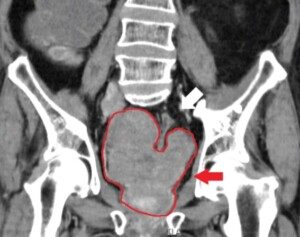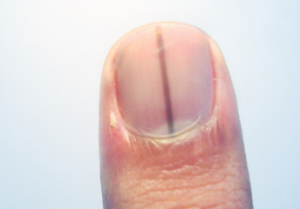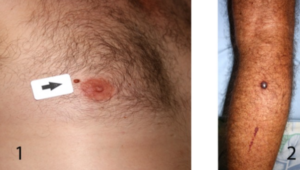Since my autism diagnosis I’ve been fascinated by stimming, even noticing that neurotypicals do this quite often.
But there are distinct differences between ASD stimming and NT stimming!
As autism is a spectrum, autistic individuals don’t all stim in the same way, just as not all neurotypicals stim identically to each other, either.
There are perhaps as many ways to engage in stimming (self-stimulatory, repetitive movements) as there are grains of sand on all the beaches in the world! Well, maybe not that much, but you get the picture.
The following are 10 types of stimming (in alphabetical order) found in Autism Spectrum Disorder.
#1. Auditory

This is that of creating or seeking repetitive sounds. This can manifest in so many ways.
A psychologist who administers autism assessments once told me she diagnosed a young child with ASD – whose parents said she could spend all day tapping on empty beverage bottles for the sound.
A well-known auditory stim is that of listening to the same song over and over and over — in a row.
There’s perhaps a blurry line where an NT’s love of a song ends and an Autistic’s fixation begins.
There’s no set number of plays that differentiates when repetitive listening crosses over to autistic listening.
However, an Autist may have the same song on repeat for hours.
I’ve listened to the same pop song 12 to 15 times in a row with no breaks.
I used to listen to the “JAWS” soundtrack so often, compressed in a relatively short period of time, that I was able to replicate it inside my head – every instrument, every dynamic change: vivid auditory imagery, as though I were actually hearing it.
Finger clicking, knuckle cracking, bubble gum popping, humming, grunting, pen clicking (Olivia Benson from Law & Order: SVU, anyone?), whistling, repeatedly strumming a few guitar strings, the sound of tearing paper – all can be examples of auditory stimming.
Most of these can be easily observed in neurotypicals as well, but are done far more frequently when it’s the stim of choice for an autistic person (e.g., ongoing humming, relentless bubble popping).
There may also be a crossover of some of these auditory stims to the next category of stimming: gustatory/oral.
#2. Gustatory or Oral

This is mainly repetitive licking or chewing. I have two forms of this: repeatedly clicking my upper to lower teeth together (mouth closed), and gently “chewing” or pressing my molars down on the side of my tongue.
I conduct these stims for prolonged periods (particularly during computer work), though there can be lengthy time passages of absence.
I simply do not know why I engage in this discreet behavior. It just happens, and on a subconscious level until I realize, “I’m doing it again,” or, “Gee, I’ve been doing it all afternoon.”
Licking, sucking or biting at sleeves or collars; licking/sucking fingers; and chewing on cuticles are additional examples.
So is “chewelry,” which is durable bracelets or necklaces that can withstand endless nibbling.
Gustatory/oral stimming can also be chewing on pencils and pens.
This is a socially acceptable form of stimming and can be observed in NTs.
#3. Olfactory

Shutterstock
Olfactory refers to the sense of smell. An Autistic may repeatedly sniff at items such as scented candles or soaps. Sometimes the object of sniffing is one’s skin.
But it can be anything, such as a new magazine or laundry detergent (I often take a whiff before using).
Or, the sniffing may be within unusual contexts. I’ve always had to take a few good sniffs of certain foods before eating them, particularly seasoned salads and anything chocolate. My NT sister has always thought that I over-smelled things.
My all-time favorite olfactory stim is that of smelling my hair! MMMMMM!
#4. Motor

Freepik
We all love our motor forms of stimming! The classics include rocking, swaying, knee bouncing, toe curling, hand or arm flapping, foot flapping and finger flicking.
I myself rock the Spectrum.
I once read a man’s post in an autism forum where he’d repeatedly bob his head.
This attracted unwanted staring, so he solved that problem by putting in music earbuds – without the music playing.
This eliminated the staring – because in the NT world, bobbing one’s head is socially acceptable only when you’re listening to music!
#5. Object
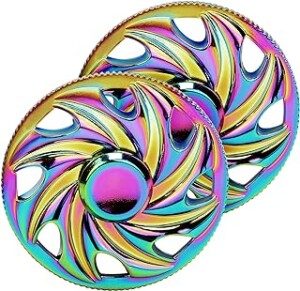
This can show as spinning anything that can be spun (wheels on a toy truck, coin on a table, “spinner ring” and the iconic fidget spinner).
It could also be stacking food cans, opening and closing lids, pulling a zipper up and down, crumpling paper, twirling a loose shoelace or other cord-like object, and flapping anything that’s in one’s hand at the moment, such as a notebook, magazine, tube of hand lotion, pen, spoon, etc.
#6. Proprioceptive
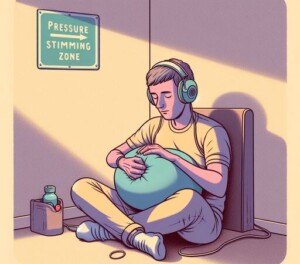
This can be squeezing one’s hands together or pressing into walls.
It could be jumping or maybe even dance moves.
This form of self-stimulatory behavior involves pressure or body awareness.
We can include heavy blankets with this category.
I engage in what I call hip adduction static holds while seated. I don’t do this for exercise; it just happens while I’m at the computer.
It’s automatic and feels so natural: one “rep” after another in which I hold the squeeze of my inner thighs together for a few seconds before releasing.
Another one that I do, which clearly involves pressure seeking, is sometimes while stopped at a light in my car or at my computer, my right hand finds its way to my left lower and inner thigh, thumb and fingers latching on – and I begin squeezing and releasing in a pulsing fashion (though not hard).
I’d never given this a second thought until I learned about stimming in autism. I’m now like, “This is a pressure stim!”
#7. Tactile

Freepik
As you know, tactile refers to touch, and in stimming, it’s repetitive touching or feeling of objects.
This can be tapping or rubbing at a specific texture, even squeezing at stress balls.
I feel my hair way more often than what a typical person does with their hair, so I consider this my tactile version of stimming. And it’s not just frequency; it’s the intense joy I derive from it.
In autism, stimming isn’t just for self-regulation, to concentrate better, to counteract anxiety or stress, or something to do when bored or to pass time. It can also be done for the joy.
In my case, feeling and smelling my hair brings incredible enjoyment. I used to think this was an odd type of vanity. I now know what it really is!
There may be some overlapping of tactile with object stimming; there are no hard rules in the categories.
#8. Vestibular

This can overlap with motor, and examples include spinning one’s body, swinging on a swing set and rolling on the floor.
When I was at a park one day, I stayed in one spot and was able to observe an autistic young adult on a swing set for at least 20 minutes of nonstop swinging.
Vestibular stimming means seeking movement related to motion – and balance.
So technically, it can also mean walking backwards on a treadmill without holding on and jumping on a trampoline.
Vestibular stims are not to be equated with similar movements that are done deliberately for exercise and achieving fitness.
For example, neurotypicals (and Autistics, for that matter) might use a “rebounder” or mini-trampoline strictly for exercise.
Yet the Autism Community Store in Aurora, CO, sells mini-trampolines, right alongside the suspended comfy pod that kids and even adults can get into for some swinging as well as pressure seeking (overlap).
#9. Visual

This means seeking visual input by prolonged observation.
The way the fluffy ponytail above squashes into the floor with each repetition really got my attention. So I took a picture. I find myself taking watching breaks while writing this article.
A classic example is the autistic child (and sometimes adult!) mesmerized by watching a spinning fan, including the giant ones on high ceilings with slow-moving blades.
The spinning object may also be a fidget. You can see the overlap here with object stimming.
Ever wonder why some autistic kids repeatedly flick or shake their fingers before their eyes?
This can be a visual stim by providing lighting contrast or the blur of the fingers.
Another example is the joy of watching things going up and down (someone on a trampoline or pogo stick, a ball bouncing, a sewing machine needle).
With myself, I can think of a strong visual stim: watching a big fat ponytail swinging back and forth like a pendulum as the person walks or jogs on a treadmill.
One day I actually got on the elliptical machine, which was right behind a treadmill where a big swinging ponytail was, just to watch the ponytail in motion.
I had completed my workout and never even use the elliptical. But it was the only way to discreetly position myself behind the woman to watch that voluminous ponytail swing in synch with her body. For a glorious 10 minutes I watched it. Oh dear, I’m autistic AF.
#10. Vocal

There’s overlap here with gustatory/oral, but more pinpointed examples include making the same sound over and over, saying the same words or phrases repeatedly, clicking the throat and humming.
Echolalia means repeating what is heard. This may happen with non-conversational Autists who may be doing this to connect with those around them.
But it also might be done by fully conversational Autistics who simply enjoy the experience of repeating out loud all sorts of verbiage – such as song lyrics, phrases from TV commercials, lines from movies or passages from books.
Final Thoughts
I hope you really enjoyed reading this proud Autistic’s explanations of the 10 different kinds of stimming behaviors.
And remember, there is overlap, which I actually think is quite cool.
Self-stimulatory behavior is part of being human, which is why neurotypicals stim too.
Even dogs stim! A dog can spend hours chewing on a “squeaky toy.” This would fulfill the criteria for auditory, gustatory/oral, object and tactile!














